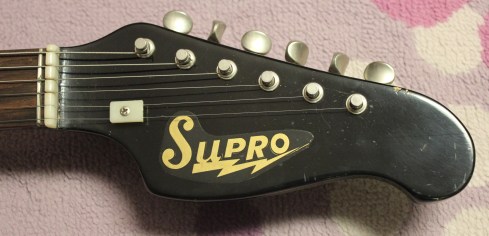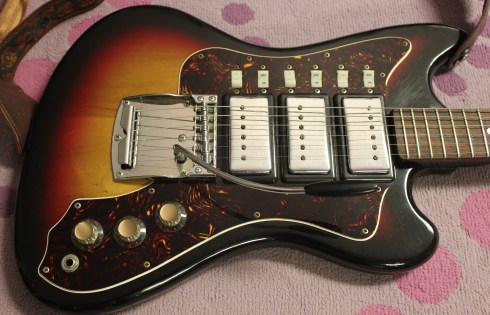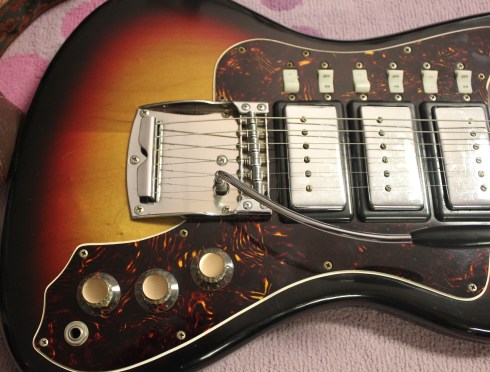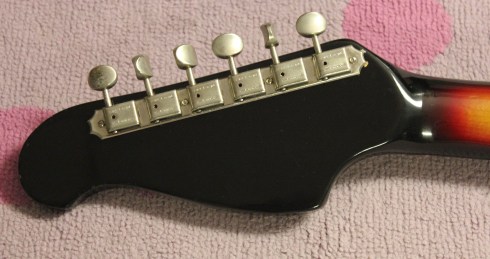This is the second article regarding Dan Auerbach guitars, and no, this one was never owned by him! But he does own an identical model and Dan used his three pickup Lexington a lot during the “Brothers” album era. When Dan was playing his Harmony guitars, I kept wondering if he would ever discover these Valco guitars, and I was happy to see him start using them around 2010! These Supro Lexingtons often really sound bad since they were wired with so much filtering. It seriously looks like amp wiring under the pickguard!! But, I’m getting ahead of myself!

Let’s start with some facts, and with this little tidbit: This Lexington was my first Valco guitar, and it’s one of the few guitars that I own that came to me bone stock mint in the case with all the original accessories!! I’m not really big on “case candy” as it were, but believe me when I say this guitar was like a time capsule straight from 1968! Oh, and one more thing! If parts of this article read familiar, like from a certain forum posting or article, don’t fret. I wrote a lot of articles years ago about these Lexingtons, and most, if not all, of the early Lexington information was written and published by yours truly. I don’t plagiarize, promise!
Ok, so the Supro Lexington was one of the last models to ever be produced by Valco, since the company had “merged” with Kay around 1967and both would soon be out of business in a few short years. The Lexington models look very similar to Fender Jaguar/Jazzmaster body shapes, but these Supro’s are much thinner at the “waist” than their Fender counterparts. 40 1/2″ long by 13″ wide. 24 3/4″ scale. They came mostly in “lustre rubbed” sunburst finishes, although slight variations in components (like tremolos, pickup covers) can give away the year of manufacture. These guitars don’t have nitrocellulose finishes.
The Lexington first appeared in late 1964 and disappeared in the late 60’s, as did most everything that was Valco. These models were initially referred to as “shaded” guitars and were available in one, two, or three pickup models. Model designations were:
- S525 (1 pu, no trem, cost $95)
- S535 (2 pu with trem, cost $169.50)
- S545 (3 pu with trem, cost $199.50)
Cases were an extra $50 at the time. Prices remained the same until they went out of business, but the model designations did change to S625, S635, and S645. The earlier models sported a tremolo system very similar to old Hagstroms of the time, whereas later Lexingtons had a slightly more sophisticated, but not that great, chrome trem with “roller” bridges and a chrome cover plate. Most definitely of Japanese origin. It’s also important to note the “sharing” of parts on many late 1960s off-brand guitars. Just like the Italian guitar makers of the 60s were being squeezed out of the market by the Japanese makers, so too were the US manufacturers. In both cases, Japanese parts began to appear and be used on domestic models. Definitely a sign of things to come! I’ve even seen these Lexington bodies/necks with Japanese pickups, STOCK!! Apparently some company was using up leftover stock as late as 1973!

Pickups were the standard Valco models, which were single coils “disguised” as humbuckers. Early model Lexingtons had some sort of gold foil/mesh on part of the pickup covers, whereas later models had the simpler chrome covers without any adornment. Part of the magic of these Valco guitars is the pickups! They were patented in the 1950s and designed by a Mr. Ralph Keller (check out the
patent information if you’re a real nut), and I think we all owe Mr. Keller a debt of gratitude. No other pickup design is like his, and if you peek under the covers of these pickups, you’ll notice that the magnet lies next to the bobbin, rather than stacked under it. I think there’s something to do with that magnet’s position and it’s magnetic pull on the strings that gives these pickups some kind of interesting, unique tone. Plus, most all these Valco pickups read out really HOT!! That can’t hurt none neither!! On mine the bridge reads out at 8.55K, the middle at 8.54K, and the neck at 8.94K.

Bodies were made of solid wood (alder?) as were the “thin-line” necks, which included a non-adjustable “Kord King” design which were guaranteed never to warp or bend! What that means is that Valco used an aluminum rod in the neck, but it’s not adjustable! I

suppose it sounded good at the time, but once these necks became warped, they are just about done as playable guitars. The Supro logo was a sort of clear sticker applied to the headstock, above the finish. Neck has a zero fret, one plastic string tree, and VERY NICE old Kluson Deluxe tuners were found on the two and three pickup models.
Frets are vintage sized, meaning small. Brazilian rosewood fretboard. Electronics had a volume knob for each pickup, and two rocker switches for each pickup. One is a simple on/off switch, and the other is a hi/lo tone switch. All electrical components are of very high quality and wiring/soldering is pretty darn good.
 suppose it sounded good at the time, but once these necks became warped, they are just about done as playable guitars. The Supro logo was a sort of clear sticker applied to the headstock, above the finish. Neck has a zero fret, one plastic string tree, and VERY NICE old Kluson Deluxe tuners were found on the two and three pickup models.
suppose it sounded good at the time, but once these necks became warped, they are just about done as playable guitars. The Supro logo was a sort of clear sticker applied to the headstock, above the finish. Neck has a zero fret, one plastic string tree, and VERY NICE old Kluson Deluxe tuners were found on the two and three pickup models.





what dose the switches do that he clicks on top of the guitar… im GUESSING turns on and off each coil. So Im Guessing as i dont know this pick up, that is is a Dual Coil and 3 of them, and that the switches above turns on and off each coil, i dont know what coils it is picking or all the ones it has on
Oh yeah, the SWITCHES!!! There are two switches assigned to each pickup. First switch is an on/off and the other is a hi/lo preset tone switch. All the knobs on this guitar are volume knobs, so the only tone controls are located in those switches.
Hi I found your article very interesting as I have just scored a 67′ Supro Strafford .The guitar has the same P/U and bridge configuration as your Lexington. What really bugs me is the very high middle P/U . Do you have ideas on how to lower them past its stock lowest height?
The only way to adjust the height on these pups is the two outermost pole piece screws. These screws pass through the pickup and into the body (maybe you already knew this!!!). You should contact Dano Dave, or send the guitar to him if you can’t get the pup low enough, or past it’s “stock height” like you mention.
I have this Guitar and theres no other sound like it, i bought it for 10 dollars and its Given me Years of Enjoyment and learning, i wonder how much the Value is in todays Market…
I have owned a Lexington since 1968. Pruchased it new. I played it through a “Heath-Kit” amp and speakers. (Garrage Band rock-n-rool) I recently had a local guy clean it up and check it out. He said I should check this site out. I had not played it for a number of years. After getting it cleaned up I had forgoten how easy it played. I would like to know what it could be worth for insurance purposes. I
Hey man, prices are all over the place right now, but I would say $500-$700 depending on condition. Thanks for sharing!
I own a Lexington. 3 PU. Played through HS & college. Purchased new in 1969. Recently had a local guy clean it up. I play a Tackamine 12 now through a Fender acoustic 30. With a gospel group. Just for fun plugged the Lexington in and was pleased how it sounded. I had forgotten how easy the Supro played. Still a nice guitar.
Cool, thanks for sharing!
I own a S545. Purchased it in ’67-’68? Gig’d with it through High School & college. Rock & Jazz. Now playing a Tak-12 in a gospel group. Recently got the Supro set up by a local guy. Did a nice job. I really forgot how easy the “old girl” played. Used it recently playing for a local amateur production of Annie, as well as the Tak. Lots of great times and memoirs with that ax.
I Have Been Handed Down My Dads First Guitar, And After Reading Your Article, I Think It Is A Lexington. How Do You Date It?
You can usually date these by serial number, but it’s often missing on these later Valco guitars. These solidbody models were only made for a few years, ca. 65-68.
I just got a great deal on the two-pickup version. The finish is pretty beat up but the neck is miraculously straight and it plays great. The problem is the electronics. Pups and switches seem to work fine, but both pots are dead and I’m getting loads of crackle/buzz/hum. Pots are attached to a little strip that has three different-sized caps on it. Am I right in guessing that there’s one cap for each pickup’s tone switch, and one for the tone knob? If so, which is which? I’d planned to get this thing working as it did new (starting with replacing the pots and hoping that’s all it needs), but you say all the weird wiring deadens what should be pretty nice pups. Am I really better off tearing it all out and wiring it like a normal guitar? Sorry about all the questions- I’m already in love with this guitar but I’ve never seen anything like the wiring on it. Thanks!
Also, you may be interested to know that it has a round plastic Kay logo on the headstock rather than the Supro sticker. Other than that it looks identical to all the Supro Lexingtons I’ve seen online.
IMO it’s totally better to pull out that strip board and remove that filtering. You can always put it all back in there if you want, but these guitar just sound so much better.
Cool, thanks. I think that’s what I’ll do. I’ll let you know how it turns out. Awesome site, by the way. I’ve always loved the looks of old, weird, obscure guitars but until I found your site I didn’t know much about their history or what they sound like.
I have a Lexington model with a single pickup and tremolo. I also have a older Custom Kraft amp. I am curious if these were sold together or any other info would be appreciated?
Guitar Model I-94038)
Amp model 600a
Thank you for your assistance
Sometimes they were sold together but not exclusively.
Hi is there a guitar wiring for this supro guitar? Can anyone help me? Thanks ron
I don’t think so, the wiring is way overly complicated…
I have a guitar the has National on the headstock and has a very similar body. The tailpiece looks the same. The pick-ups and knobs also. I wish I could leave a photo, as I’ve never been able to find another one the same as mine. Finding this page points me in the right direction…….?
If you want, use the contact form here on the site to exchange pics…